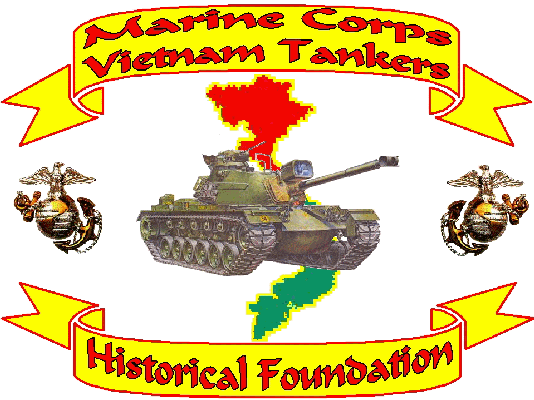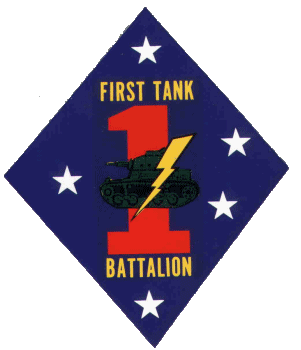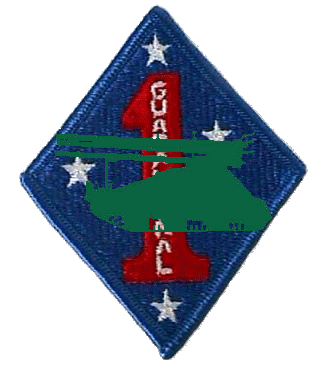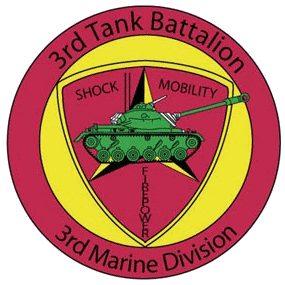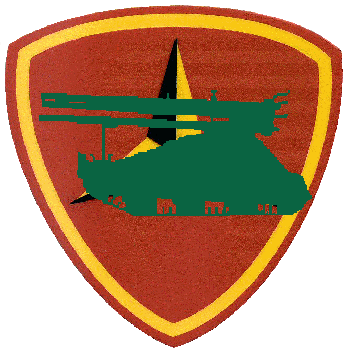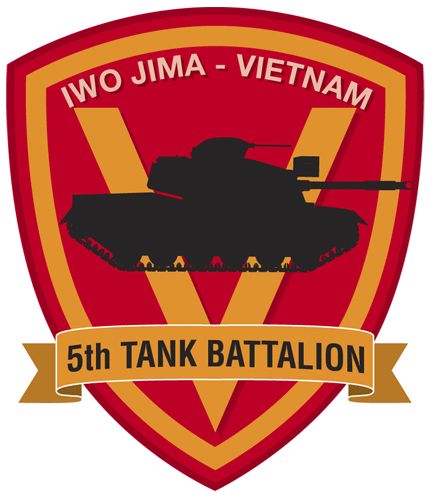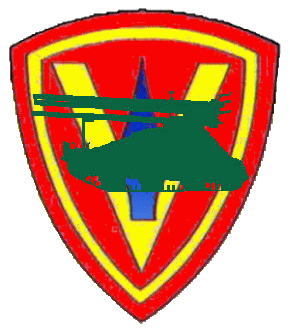|
Carl "Flash" Fleischmann's Truck
By JO1(SW) Spencer Webster
Staff Writer
The loud rumbling of the silver-colored
Dodge Ram 2500 turned my head, but as the truck passed by me, the mural
painted on the tailgate captured my attention. It was not so much the
Vietnam Veteran theme of the images that caught my eye, but the loving
care in which they had been painted. Curiosity took me over and I had to
ask – what was the story behind the mural?
For Carl Fleischmann, former U. S. Marine, the story began in March of
1967 as he attended 13 weeks of Marine boot camp at Parris Island.
Following boot camp, he traveled to Camp LeJeune,
North Carolina, where he attended basic Infantry Training Regiment (ITR),
which taught him how to advance on hills and how to use various weapons.
After he graduated from ITR, he traveled
to California to attend the Tracked Vehicle School at Camp Del Mar at
Camp Pendleton. This is where he would learn his skills as a member of a
tank crew of the M48A3 “Patton” tank, which motivated Fleischmann a lot.
“For a 17-year-old kid, it was very interesting because there was this
52 ton vehicle that he could shoot, drive and maintain,” he said. “I was
very impressed with the tank. I remember driving on to a landing craft
and having it be dropped off and driving it to the beach.”
Fleischmann felt a sense of pride and ownership during his tank
training. “Kids, who before that, had only taken care of bicycles before
that, were now entrusted with a tank. Once you got your own tank, it was
a source of deeper pride; the taking care of it and keeping it in
top-running condition,” he said.
Following completion of his tank training in mid 1967, Fleischmann
attended 50-cal School and a linguistics and interrogation training at
29 Palms, prior to shipping over to Vietnam.
Fleischmann left his schooling a confident young man, but he discovered
he was unprepared for the reality of Vietnam. “When we got to Da Nang,
there was a rocket mortar attack on the airfield,” he said. “It was
pretty interesting but I was a kid again because I’d seen dead and
wounded soldiers and this scared me. It was sobering.”
He was taken, along with nine other people, to Phu Bai via helicopter,
where he was assigned to the Third Tank Battalion, Third Marine
Division, Headquarters and Service Company (H&S Co.) to re-supply
manpower for the tanks. Fleischmann’s role in H&S Co. was to provide
manpower, parts and supplies for the forward tank companies (A-C), which
were used for convoys, various patrols and covering support for the
infantry. The fast and furious nature of getting indoctrinated into war
mode, where he received his weapons, protective gear and information
about where he would sleep or where to go in case of attack, overwhelmed
him.
“During a watch, I found myself looking
past drums filled with dirt, sand bags, down a barrel of my weapon
through the barb wire and claymore mine field to the country side,” he
said. “This is real. We are not home and playing any more.”
In early 1968, the war presented an even
starker view to Fleischmann, when he found himself in a convoy heading
toward Hue (pronounced way) City. “Before we pulled out, it was quiet,
which was unusual and eerie,” he said. “Then, when we got to Hue City,
the Tet Offensive had started, where all the main cities of South
Vietnam were attacked and overrun at the same time by the North
Vietnamese Army (NVA). This was the first time I saw someone, a Marine,
advancing with us, shot right in front of me and it changed me. I
realized how fragile we are. When someone dies within 10 feet of you,
and you hear it, it gives you a different perspective.”
However, Hue City was not done changing Fleischmann’s life. He found
himself participating in house to house battles, something that had not
been done since the days of World War II. During one of these battles,
he, as the tank driver, noticed through a viewing hole an enemy soldier
as he pointed a rocket propelled grenade launcher at his tank.
“Before he shot, I turned the wheel (and the tank) to reduce the impact
of the grenade. The rocket hit, and the tank filled with smoke,” he
said, “No one inside the tank with me got hurt, so I got the tank back
to a safe area.” Fleischmann opened the tank commander’s turret and
discovered that his commander, Cpl. Robert Hall had suffered mortal
injuries.
“I took him back to the Military
Assistance Compound, Vietnam (MACV) Company Headquarters for Hue City,
trying to get medical assistance for him, but a corpsman came out and
told me there was nothing they could do for him,” he said. “I held onto
Robert, who was gurgling and basically drowning in his own blood as he
held onto me with what was a death grip on my shoulder until he passed
away.” Fleischmann took the death of his tank commander very hard,
because every member of the tank crew was part of a close-knit team;
they ate chow together, wrote letters together and talked of family life
at home.
“To have someone die in your arms and not
be able to do anything about it was brutal! I closed up and there was no
one I could talk to, especially as it took us a month to get out of Hue
City,” he said. “That was when I went hard – the enemy really became the
enemy – it was personal. Nothing bothered me after that and no one could
get close to me.” After he left Hue he was ordered to Quang Tri where he
and the rest of his crew traveled their separate ways, because the loss
had been too great and the memories too difficult, so they all asked for
transfers.
As a result, Fleischmann joined a tank
crew in C Co., commanded by Cpl. John Wear, where he participated in
patrols that led to the demilitarized zone (DMZ), Con Thien (pronounced
con-tea-en), Camp Carroll and Leatherneck Square. “He came to my crew as
the gunner, which was inside the tank,” said Wear, “and being inside of
the tank had an adverse effect on him because he could not see the
enemy. We were in several a static positions after six months and he
wanted to be on the ground, combating the enemy, up close and personal,
so he asked for a transfer.”
At that time, Fleischmann was six foot
tall and weighed 106 pounds, so he became a perfect candidate for being
a tunnel rat, which gave him an increased ability to meet the enemy on
his terms. “We got to go out on more patrols, day and night,” he said.
“We were the first in the towns and villages and if we found a tunnel, I
got to go inside first. I didn’t have the fear.”
A normal tour in Vietnam for Marines was 12 months but Fleischmann asked
for and received a 6-month extension and by his 18th month, he’d been
awarded three Purple Hearts, two for his action in Hue City and one at
the Cua Viet River. He returned to Camp LeJeune and was given a choice
of duty, and he chose duty closer to his home state of Connecticut at
Quonset Point Naval Air Station in Rhode Island, where most often, he
stood gate security as part of the Marine Barracks there. But shortly
after that, in late 1969, he was medically discharged.
“I fought for five years to get back into the Marine Corps but I tried
to adjust to civilian life,” he said. “I still wish I could have been
able to get back in.”
He returned to Connecticut at Groton, where he continued to work for the
U. S. government, but as submarine builder for Electric Boat, followed
by a move to Keyport, Washington, where he built torpedoes. Along the
way during his civilian life, he has suffered numerous illnesses that
were attributed to his exposure to Agent Orange, most recently; he has
recovered from prostrate cancer. For Fleischman, he may have left
Vietnam, but in every aspect of his life, Vietnam never left him,
especially the loss of his friend and tank commander, Cpl. Robert Hall.
“Over a year ago, I bought a 2004 Dodge 2500 4X4 pickup truck and I
wanted to do something special with it but I did not have an idea of
how,” he said. “I told my family I wanted something done – to remember
my buddy Marines; a memorial of some sort.”
His wife, Gail, son Carl and daughter Christa, got together over dinner
one night and decided on an initial design, which had been penned out on
a napkin, and showed it to Fleischmann, who liked it. The junior Carl
Fleischmann took the design to an artist/painter acquaintance, Tony
Crosta, who paints tailgates, motorcycles and bicycles in Port Orchard.
“I took their ideas and drew up a concept; took all the elements and
drew an initial drawing,” said Crosta, “based on conversations about the
whole story of the tank commander. I spent a day on research, looked at
a model of the tank he was in and put my heart and soul and time into
this project. Accuracy was important to me.” After Crosta completed the
project, he presented it to Fleischmann.
“I cried like a baby. The design they came up with was exactly what I
was looking for,” he said, “in fact, it exceeded my expectations.” The
truck is no longer a truck to Fleischmann or his family, but has become
a living memory of a long-dead but never forgotten friend.
“My family understands me and my
experiences a little better because of the truck,” he said. “When I cry,
they know why. To this day, I am afraid of losing people close to me.
Robert will always be a part of my life and he will be in Heaven waiting
for me. There are still things I cannot talk about with regard to
Vietnam, but this truck has opened me up for Robert.”
The power of the mural on the tailgate of the truck has spread to other
people, including the artist himself. “It gave me a new respect for what
they (Vietnam Veterans) went through,” said Crosta. “I hadn’t known
anyone who had been through that. It means a lot for me and I feel like
I have impacted a lot of people. I knew I did my job. People stop and
talk with me or leave notes on my windshield about taking photos of the
truck,” said Fleischmann, “so I know it affects people. At my house, the
Marine Corps Flag and the American Flag fly at the same time. I am proud
to be an American and proud to be a Vet. I wouldn’t change a moment in
my life, because it makes you who you are.”
Brian Nokell, Photographer, Naval Base
Kitsap - Bangor, Visual Information
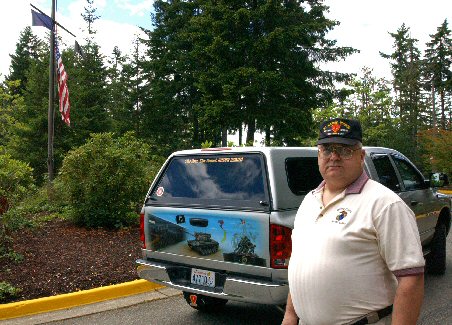
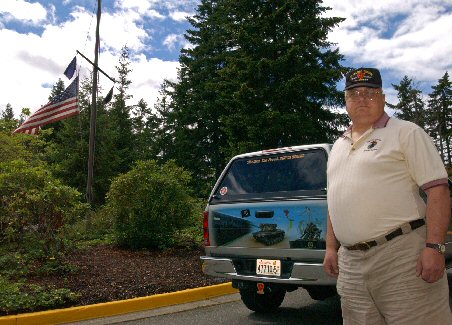
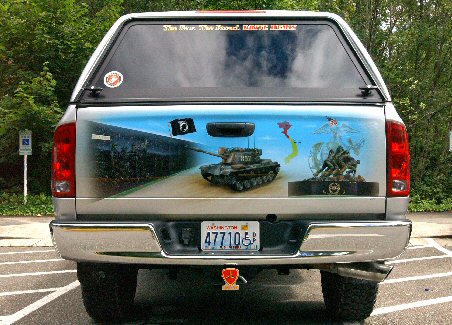
|
